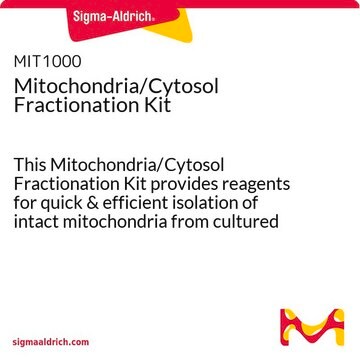MITOISO3
Yeast Mitochondria Isolation Kit
sufficient for 40 applications (using 20 OD culture preparations), isolation of an enriched mitochondrial fraction from yeast cells
Autenticatiper visualizzare i prezzi riservati alla tua organizzazione & contrattuali
About This Item
Codice UNSPSC:
12352200
NACRES:
NA.32
Prodotti consigliati
Livello qualitativo
impiego
sufficient for 40 applications (using 20 OD culture preparations)
Temperatura di conservazione
−20°C
Descrizione generale
Mitochondria, the site of most of the energy production in eukaryotic cells, are characterized by a double membrane structure, an outer membrane and folded inner membrane. Isolated mitochondria may be used as tools for in vitro studies such as respiration and energy production studies, apoptosis, mtDNA and mtRNA, and mitochondrial protein profiling.
Applicazioni
The kit contains all the reagents required for yeast cell wall lysis by lyticase (spheroplast formation) followed by cell membrane lysis/breakage and mitochondria isolation. In addition, the kit includes an extraction buffer for mitochondrial protein profiling to be used in proteome studies and a storage buffer for use with intact mitochondria. Yeast Mitochondria Isolation Kit has been used in the isolation and extraction of mitochondria.
Caratteristiche e vantaggi
• The kit′s features include speed, sensitivity, ease of use, and specificity
• The kit contains all the reagents required for a fast and easy yeast cell wall lysis by lyticase (spheroplast formation) followed by cell membrane lysis/breakage and mitochondria isolation
• The kit provides two alternatives for cell membrane disruption. The first one by a detergent and second one by homogenization.
• The kit includes an extraction buffer for mitochondrial protein profiling to be used in proteome studies
• The kit includes a storage buffer for use with intact mitochondria.
• The reagents are sufficient for 40 procedures using 20 OD culture preparations
• The kit was tested on Saccharomyces cerevisiae, Pichia pastoris, and Schizosaccharomyces pombe
• The kit contains all the reagents required for a fast and easy yeast cell wall lysis by lyticase (spheroplast formation) followed by cell membrane lysis/breakage and mitochondria isolation
• The kit provides two alternatives for cell membrane disruption. The first one by a detergent and second one by homogenization.
• The kit includes an extraction buffer for mitochondrial protein profiling to be used in proteome studies
• The kit includes a storage buffer for use with intact mitochondria.
• The reagents are sufficient for 40 procedures using 20 OD culture preparations
• The kit was tested on Saccharomyces cerevisiae, Pichia pastoris, and Schizosaccharomyces pombe
I componenti del kit sono disponibili anche separatamente
N° Catalogo
Descrizione
SDS
Prodotti correlati
N° Catalogo
Descrizione
Determinazione del prezzo
Avvertenze
Danger
Indicazioni di pericolo
Consigli di prudenza
Classi di pericolo
Acute Tox. 4 Oral - Aquatic Acute 1 - Aquatic Chronic 1 - Carc. 2 - Eye Dam. 1 - Repr. 2 - Resp. Sens. 1 - Skin Irrit. 2 - STOT RE 2
Codice della classe di stoccaggio
10 - Combustible liquids
Scegli una delle versioni più recenti:
Possiedi già questo prodotto?
I documenti relativi ai prodotti acquistati recentemente sono disponibili nell’Archivio dei documenti.
I clienti hanno visto anche
Shui-Xiu Li et al.
Frontiers in microbiology, 9, 1025-1025 (2018-06-08)
Previous work has explored link between mitochondrial biology and fungal pathogenicity in F1Fo-ATP synthase in Candida albicans. In this work we have detailed the more specific roles of the F1Fo-ATP synthase β subunit, a key protein subunit of F1Fo-ATP synthase.
Christian Streng et al.
The EMBO journal, 40(17), e108083-e108083 (2021-07-14)
Mitochondria are essential organelles because of their function in energy conservation. Here, we show an involvement of mitochondria in phytochrome-dependent light sensing in fungi. Phytochrome photoreceptors are found in plants, bacteria, and fungi and contain a linear, heme-derived tetrapyrrole as
Erika Steele et al.
Microbial cell factories, 20(1), 138-138 (2021-07-21)
Myo-Inositol Phosphate Synthase (MIP) catalyzes the conversion of glucose 6- phosphate into inositol phosphate, an essential nutrient and cell signaling molecule. Data obtained, first in bovine brain and later in plants, established MIP expression in organelles and in extracellular environments.
María Guirola et al.
The Biochemical journal, 432(3), 595-605 (2010-09-23)
The Saccharomyces cerevisiae gene PIF1 encodes a conserved eukaryotic DNA helicase required for both mitochondrial and nuclear DNA integrity. Our previous work revealed that a pif1Δ strain is tolerant to zinc overload. In the present study we demonstrate that this
Panos Oikonomou et al.
Proceedings of the National Academy of Sciences of the United States of America, 117(43), 26710-26718 (2020-10-11)
Large-scale proteomic methods are essential for the functional characterization of proteins in their native cellular context. However, proteomics has lagged far behind genomic approaches in scalability, standardization, and cost. Here, we introduce in vivo mRNA display, a technology that converts
Articoli
Cellular oxidative stress is countered by enzymatic scavengers and antioxidant modulators against reactive oxygen species damage.
Il team dei nostri ricercatori vanta grande esperienza in tutte le aree della ricerca quali Life Science, scienza dei materiali, sintesi chimica, cromatografia, discipline analitiche, ecc..
Contatta l'Assistenza Tecnica.











